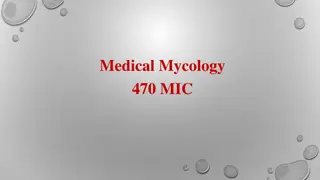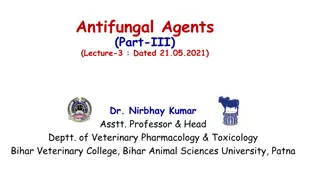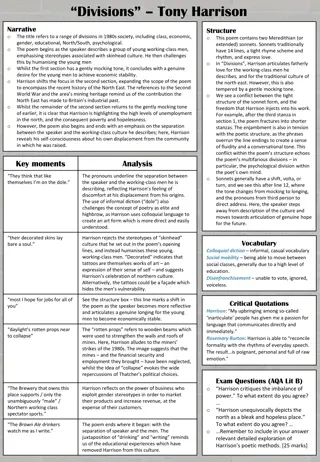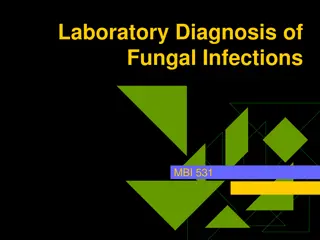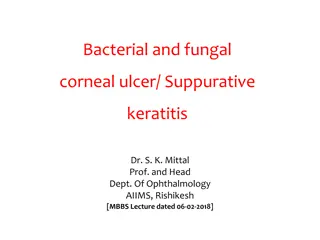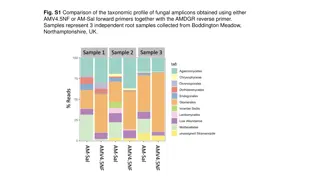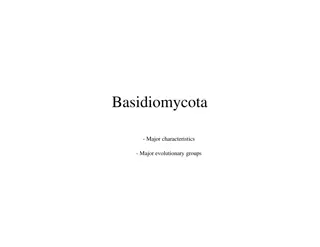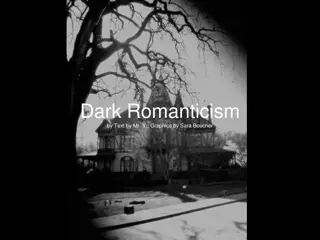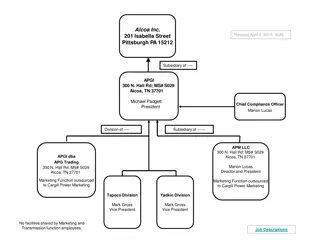Key Characteristics of Fungal Divisions and Sub-Divisions
Identification key for important characteristics of fungal divisions and sub-divisions, including Myxomycota and Eumycota, with detailed descriptions of sub-divisions such as Mastigomycotina, Zygomycotina, Ascomycotina, Basidiomycotina, and Deuteromycotina. Focus on distinguishing features, reproductive methods, and specific characteristics of classes and orders within the fungal groups.
Download Presentation

Please find below an Image/Link to download the presentation.
The content on the website is provided AS IS for your information and personal use only. It may not be sold, licensed, or shared on other websites without obtaining consent from the author. Download presentation by click this link. If you encounter any issues during the download, it is possible that the publisher has removed the file from their server.
E N D
Presentation Transcript
KEY TO IDENTIFICATION OFIMPORTANT CHARACTERISTIS OF DIVISIONS AND SUB-DIVISIONS DIVISIONS : 1. MYXOMYCOTA: Plasmodial forms with out cell wall. Plasmodium is a naked multinucleate mass of prAlsocalled slime molds. 2. EUMYCOTA: True fungi. Thallus is typically filamentous with cell wall. Plasmodium absent. SUB DIVISIONS OF EUMYCOTA : 1. MASTIGOMYCOTINA : Thallus is unicellular . Asexual spores are zoospores (motile spores).Sexual spores are oospores. Sexual reproduction by gametangial contact. 2. ZYGOMYCOTINA : Thallus is aseptate mycelium. Motile spores are absent. Asexual spores are sporangiospores (aplanospores).Sexual spores are zygospores.Sexual reproduction through gametangial copulation. .
ASCOMYCOTINA : Thallus is septate mycelium. Rarely unicellular. Motile spores are absent. Asexual spores are conidia.Sexual spores are ascospores produced endogenously in an ascus.Sexual reproduction mainly by gametangial contact . . 4. BASIDIOMYCOTINA: Thallus is septate mycelium.Motile spores are absent.Clamp connections and dolipore septum are present.Sexual spores are basidiospores produced exogenously on basidium.Sexual reproduction is by spermatization and somatogamy. 5. DEUTEROMYCOTINA: Thallus: septate mycelium . Motile spores are absent. Sexual spores are absent. Asexual spores /conidia are present.
SUB - DIVISION: MASTIGOMYCOTINA IMPORTANT CHARACTERISTICS OF CLASS OOMYCETES 1. Members may be aquatic or terrestrial ,saprophytes or obligate parasites. 2. Thallus - mostly eucarpic ,coenocytic 3. Cell wall consists of cellulose. 4. Asexual reproduction is by zoospores produced in zoosporangia. 5. Sexual reproduction is oogamous type ie.,gametangial contact/gametangy. 6. Zygote resulting from sexual reproduction is called oospore. 7. Oospore is the sexual resting spore which is the characteristic of oomycetes. 8. This zygote/ oospore is diploid 9. Meiosis occurs in gametangia instead of zygote.
IMPORTANT CHARACTERISTICS ORDER PERONOSPORALES: 1.Many species are destructive pathogens causing very serious diseases in some important crop plants. 2.Members are mostly terrestrial. 3.Mycelium is coenocytic, produce inter and intra cellular hyphae. 4.Sporangia are produced on well developed, distinct sporangiophores. 5.Sporangiophores may be indeterminate / indefinite type or determinate/definite type 6.Zoospores are monomorphic (producing morphologically one type of zoospores i.e., reniform zoospores and monoplanetic. 7.Zoospores are reniform and biflagellate. 8.Oogonium produces a single oosphere / egg surrounded by conspicuous periplasm except in Family: Pythiaceae in which periplasm is inconspicuous.
ORDER PERONOSPORALES : Families: 1.Pythiaceae 2.Albuginaceae 3.Peronosporaceae These three families are distinguished based on characteristics of sporangiophores and sporangia. IMPORTANT CHARACTERISTICS OF FAMILY 1. PYTHIACEAE: 1.Species may be saprophytes or facultative parasites.Commonly called water molds. 2.May be inter or intra cellular mycelium. 3.Sporangiophores generally not distinguished from somatic hyphae unless sporangia are present. 4.Sporangiophores are indefinite or indeterminate type . 5.In oogonium ,Periplasm is inconspicuous (not visible). Eg. Pythium and Phytophthora
2 FAMILY ALBUGINACEAE 1.Members are obligate parasites. 2.Mycelium is intercellular. 3.Sporangiophores are short, unbranched, club shape and indeterminate type. 4.Each sporangiophore gives rise to several aporangia which are produced in basipetal manner . 5.Sporangia are globose and are connected by isthmus or disjunctor cell 6.Periplasm is conspicuous. 7.Single genus under the family i.e., Albugo.
FAMILY:3.PERONOSPORACEAE 1. All the members are obligate parasites of plants causing diseases called downy mildews. 2. Mycelium is coenocytic and intercellular. 3.Sporangiophores are well developed, specialized , characteristically branched and determinate type. 4.Sporangia deciduous, may be papillate or may not be papillate. In most genera, sporangia germinate by zoospore. However, in some species they germinate by germ tube and function as conidia. 5.Oospores may be plerotic or aplerotic. 6.Periplasm conspicuous. Eg:Sclerospora, Peranospora
The members are further divided into different genera and distinguished based on two characteristics viz., 1. morphology of sporangiophore ( branching pattern) 2. method of germination of sporangia. Eg. Peronospora, Pseudoperonospora, Peronosclerospora, Sclerospora, Plasmopara, Bremia. DISTINGUISHING CHARACTERISTICS OF DOWNY MILDEW GENERA: PERONOSPORA: Sporangiophores are dichotomously branched 2-7 times at acute angles and tips of branches are curved and pointed bearing sporangia on sterigmata. Sporangia are hyaline ,ovoid ,non-papillate and always germinate by germ tube. i.e.,sporangia behave like conidia. Eg;Peronospora destructor-downy mildew of onion. Peronospora
PSEUDOPERONOSPORA:Sporangiophores are branched at acute angles with curved,blunt tips,bearing sporangia on sterigmata.Sterigmata are unequal ( 1 big and 1 small ). Sporangia are greyish,ovoid,papillate and germinate by zoospores. Eg.Pseudoperonospora cubensis -downy mildew of cucurbits PERONOSCLEROSPORA:Sporangiophores are erect,short,stout,widening towards upper portion,dichotomously branched 2 -5 times at apex bearing sporangia on sterigmata. Sporangia are hyaline,elliptical or ovoid,thin walled, non-papillate and germinate by germ tube like Peronospora. Oospore is plerotic type like Sclerospora. Eg.Peronosclerospora sorghi-downy mildew of jowar P.philippinensis-downy mildew of maize
SCLESPORA:Sporangiophores are stout ,having upright branches, bearing sporangia on sterigmata. Sporangia are h yaline ,ovoid,smooth walled,papillate and germinate by zoospores.Oospore is plerotic. Eg.Sclerospora graminicola downy mildew of bajra. Sclerospora PLASMOPARA;Sporangiophores are branched at right angles to the main axis at regular intervals. Monopodial branching is observed. Eg.Plasmopara viticola-downy mildew of grapes Plasmopara
SUB-DIVISION: ZYGOMYCOTINA CLASS: ZYGOMYCETES IMPORTANT CHARACTERISTICS OF CLASS: ZYGOMYCETES, ORDER:MUCORALES: 1.Production of non- motile sporangiospores (aplanospores). 2.Production of thick walled resting spore-zygospore 3.Well developed , coenocytic mycelium and cell wall with chitin 4.Asexual reproduction is by sporangiospores though some species produce Chlamydospores. 5.Sexual reproduction is by gametangial copulation. FAMILY:MUCORACEAE: Eg.Rhizopus stolonifer Commonly called as breadmold
1.Well developed coenocytic mycelium.Mycelium is differentiated into rhizoids, stolons and sporangiophores 2.Rhizoids are root like structures, which are useful for anchoring the thallus into the substratum and for absorption of nutrients. 3.Stolons or runners are aerial hyphae which grow on the surface of substratum. 4.Each sporangiophore bears a single sporangium at its tip. 5.Asexual reproduction is by non-motile sporangiospores.
6.Heterothallism was discovered in 1904 by A.F.Blakeslee, which is favoured by sexual harmones called gammones or trisporic acid 7.Sexual reproduction is by isogametangial copulation leads to formation of zygospore Diseases: Soft rot of sweet potato, fruits and vegetables. Zygospore


